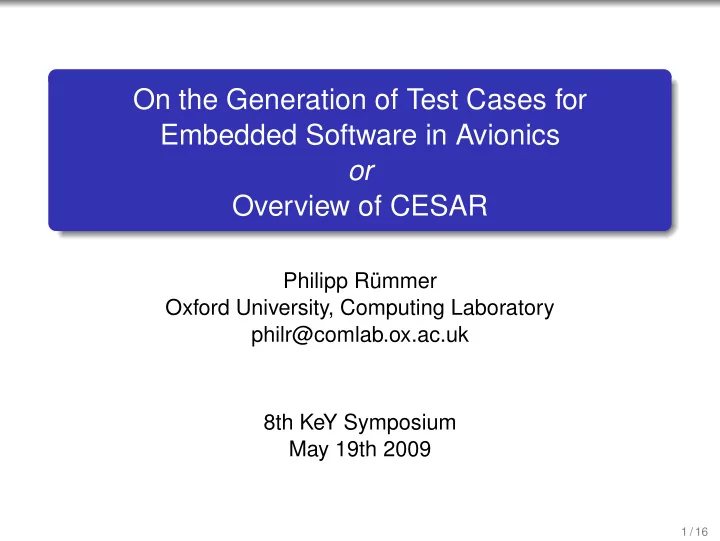

On the Generation of Test Cases for Embedded Software in Avionics or Overview of CESAR Philipp Rümmer Oxford University, Computing Laboratory philr@comlab.ox.ac.uk 8th KeY Symposium May 19th 2009 1 / 16
The Wonderful World of Oz Model Checking Background: I recently joined Daniel Kröning’s group in Oxford (. . . after 8 years of KeY . . . ) Now employed by the CESAR project Outline of the talk: Overview of CESAR Model checking Matlab/Simulink (Bounded) Model checking to generate test cases 2 / 16
CESAR “ C ost- E fficient methods and processes for SA fety R elevant embedded systems” Artemis project Project started March 1st 2009 Some universities involved: Oxford , Manchester, INRIA, KTH, Athens, + Fraunhofer Some industry partners: Airbus/EADS, Volvo, Thales Overall project topic: Introduction of formal methods in development of embedded software Domains: Aerospace , Automotive, Rail, Industrial automation 3 / 16
CESAR: Most relevant sub-projects SP2: Requirements engineering Define a formalised requirements capturing language In particular also: non-functional requirements Support requirement validation: consistency, completeness SP3: Component-based development Defined a component-based design language Incremental approaches for validation, verification, certification and qualification 4 / 16
Simulink as de facto standard for embedded software 5 / 16
Simulink for embedded software (2) Graphical dataflow language on top of Mathwork’s Matlab Supports discrete + continuous dataflow + stateflows Automatic simulation and code generation S-functions Further relevant language: Lustre/Scade 6 / 16
Simulink for embedded software (2) Graphical dataflow language on top of Mathwork’s Matlab Supports discrete + continuous dataflow + stateflows Automatic simulation and code generation S-functions Further relevant language: Lustre/Scade Issues with Simulink Quite low-level No (strong) encapsulation Unclear semantics 6 / 16
CESAR SP3: Component-based development New high-level component-based modelling/design language (CBD language) Mainly: University of Manchester Verification methods for: CBD language, Simulink, Lustre, etc. Primary approach: white-box test-case generation Model checking as underlying method Focus on: compositionality, replicated components Tool support Compositionality and coverage criteria Mainly: Oxford University 7 / 16
Model Checking Algorithmic verification approach (in contrast to: deductive) Applicable to properties in temporal logic Can generate counterexamples for violated properties Two kinds of model checking that are mostly unrelated: (Full) Model checking Bounded model checking 8 / 16
Full model checking Basically: Exhaustive search in the state space of a program Explicit or symbolic Abstraction to make state space small/finite Tool developed in Oxford: SatAbs 9 / 16
Bounded model checking Principle of bounded model checking Examine finite unwinding of program: I ( s 0 ) ∧ R ( s 0 , s 1 ) ∧ · · · ∧ R ( s n − 1 , s n ) ∧ ¬ P ( s n ) I ( s ) . . . Initial states R ( s , s ′ ) . . . Transition relation of program P ( s ) . . . Safety property to be checked Typically: completely propositional encoding Incomplete for verification, but complete for disproving safety properties Quite similar to KeY . . . (yes it is!) How to encode heap? ( → answered by Carsten) Tool developed in Oxford: CBMC 10 / 16
Test case generation using model checking Basic idea: Specify trap properties and use counterexample from model checker as a test case Idea goes back to 1996, Callahan, Engels Model-based testing technique Example (Model checking to achieve statement coverage) 1: void f(int x) { 2: ... 3: if (x > 10000) 4: causeSegFault(...); 5: } How to reach the blue statement? Trap property: � ( pc � = 4 ) Counterexample found: f(10001) 11 / 16
Test case generation using model checking (2) Criteria that are most relevant for us: Structural coverage Trap properties to cover: Statements, control edges, MC/DC Dataflows Mutation detection Generate faulty mutants of program: Exchange operators, literals, introduce bit-faults, etc. Try to verify equivalence of original program and mutant ⇒ Use counterexample as test case Hypothesis: coupling effect Tests that detect simple faults probably also detect complex faults 12 / 16
Verification of Simulink programs using CBMC For discrete dataflow and stateflows : Compile Simulink model to imperative program Statically generate schedule for program (order in which Simulink blocks are executed) C library with implementations of blocks Simply include code for S-functions Resulting code can be model-checked Counterexamples/tests can be translated back to Simulink Alternative approach: compile Simulink to Lustre PhD student working on Simulink front-end for CBMC : Michele Mazzucchi (ETH) Unclear: how to handle continuous dataflow? 13 / 16
Floating-point arithmetic Essential to analyse Simulink models Difficult to handle also in bounded model checking Bit-precise encoding: large and very hard for SAT-solvers Interval arithmetic: no counterexamples ⇒ unusable Approach currently investigated in our group Bit-precise encoding Combination under- and over-approximation Over-approximation: Only include clauses for higher-valued bits Under-approximation: Assert that lowest-valued bits are zero PhD student working on floating-point support: Angelo Brillout (ETH) 14 / 16
Conclusion Overall goal of CESAR: Improve quality + reduce costs of embedded software using formal methods Testing ⇒ Independent of compilers correctness, hardware, etc. (in contrast to deductive verification) Bounded model checking to generate tests CESAR includes pilot applications for evaluation: Aerospace, Automotive, Rail, Industrial automation Future work: basically everything 15 / 16
Thanks for your attention! 16 / 16
Recommend
More recommend